How Do Sails Actually Work: Full Beginners Guide
The sails are your boat's primary driving force. Your boat is designed to sail, and with good wind it will be faster and more comfortable than using the engine. Engines on sailboats are called "auxiliary" for a reason, almost every sailor hates to use them once they get the hang of sailing. But it won't happen if you don't learn to trim the sails, and to trim them you have to understand them.
But how does a bunch of cloth - your sails - get so much motive power and force? How do sails actually work?
The short answer is that upwind sails generate lift which acts against forces on the keel in the water to pull the boat forward, and downwind sails capture as much wind force as they can to push the boat downwind.

But the detailed answer for sailing upwind is more complex, so come join us for a deep dive into the reason sailboats work and can sail up, down, and across the wind. It's going to get a little into math and a little physics, but we'll keep it on a practical level where you can get the concepts with little hard stuff. And downwind sails are much easier to explain.
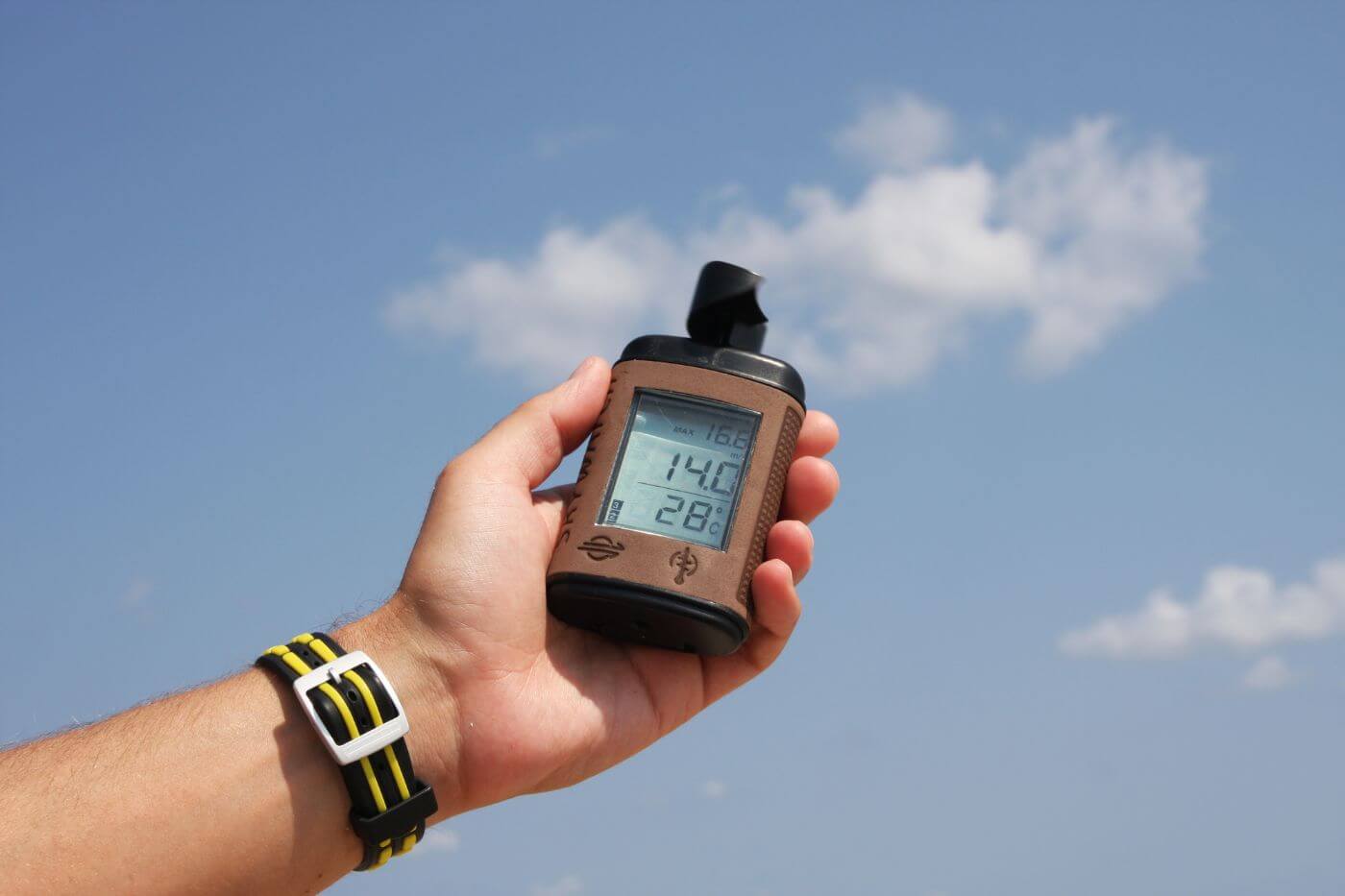
How Sailing Requires Some Math
To understand sails and sailing, understand the forces which apply to a boat and how they combine to make forward motion. To represent forces, motion, and velocity, we need to use vectors.
We'll do our best to keep this simple, and you will not need a calculator. The important takeaway is how we add forces together to figure a net force or motion.
What is a Vector?
A vector is a number with both a magnitude (a number or size) and a direction. Traveling at 60 miles per hour down the highway is a speed—the car's speed is 60 mph no matter where it’s headed. It has no direction component. But traveling west at 60 mph is a velocity, which is a speed and a direction (west).
You represent the speed easily with a number: "60." But how do you show its velocity headed west? Just as easily, with a vector.
Draw a six-inch line running east/west, then put an arrow on the west end. If we set our scale to one inch = 10mph, then we have our scalar measurement (6") and our orientation - west, or 270°. This arrow is the velocity vector of a car moving at 60mph headed west.
You can represent anything with an orientation and a scalar measurement this way. Whether it's the force and direction a pool cue applies to a ball, the force a hammerhead puts on a nail or the speed and direction of the wind, you can show it with vectors.
Calculating the sailing vector (with pictures)
So what is the point of drawing arrows to describe things? If we can describe forces with vectors, then we can add and subtract the vectors to see how the forces add and subtract, too.
Adding vectors is simple. To add two vectors, put the arrow end of the first vector at the beginning of the second vector. Then, with a straight edge, draw a line from the start of the first vector to the end of the second and put an arrow on the end where it meets the second vector. That new line you just drew is the sum of the vectors.
That's all there is to it. But what does it mean? Let's do a couple of thought exercises to show how it works.
Picture a bicyclist riding north along a road at 20 mph with no wind. The bicyclist feels a 20 mph north wind in her face, right? You can draw that as a line 20 units long pointing directly at the rider's face. The exact units on paper don't matter. That they're consistent is all that counts, so "one square of graph paper = one unit" and "one unit equals one mph" is just fine.
Now picture a 10 mph north wind from straight in front of the rider. What does it feel like to the rider?
That 10 mph wind is added to the 20 mph wind, and it feels like the rider is moving into a 30mph wind. You don't need vectors to see this, it's simple math, and you know how this feels. Just like you know a 10 mph south wind from straight behind the rider will make the total wind feel like just 10 mph.
But what about if there's a 10 mph wind from the east - 90 degrees from the rider's right? What does the wind force feel like in her face now?
- Draw your 20-unit north wind line in the rider's face.
- From the end of the first line, draw a 10-unit east wind.
- With a straightedge, draw a line from the beginning of the north wind vector to the arrow on the east wind vector.
- That line is what the rider feels in her face from the combined wind of her motion on the bike and the 10 mph east wind.
- You can measure the exact angle of the new vector with a protractor or compass and measure the length in units to get the wind strength. You'd get a wind that felt like 22.4 mph from 26.6° to the rider’s right.

Vector A, the north wind (0°) 20 mph long, and B is the east wind (90°) at 10 mph
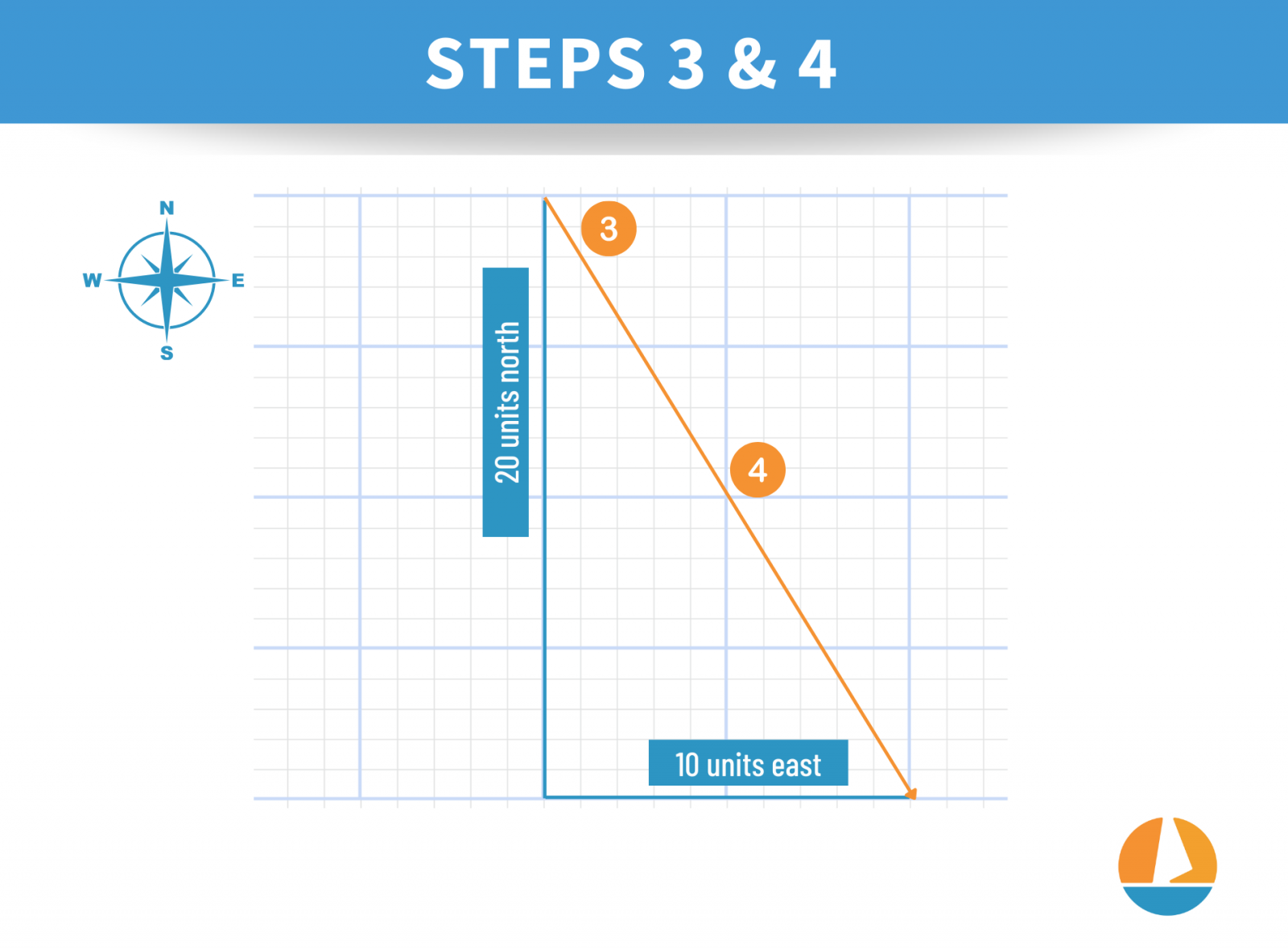
The line is drawn to add them together.

The new vector for the wind force.
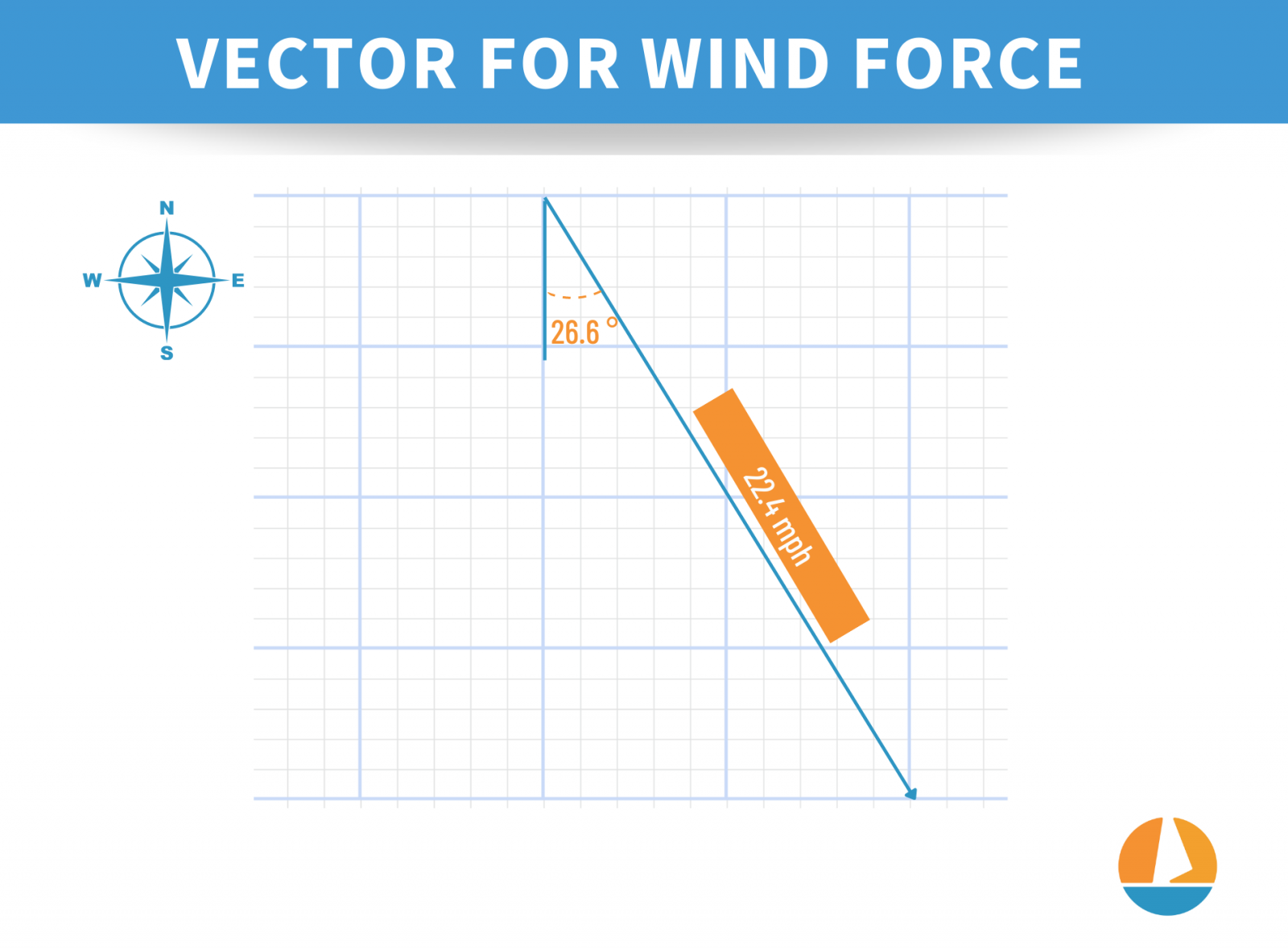
To explore this further, check out the tool used to make these graphics, where you can create your own vectors and add them together. Just remember it's made by mathematicians, not sailors, so North (0°) is to the right instead of up!
Applying vectors when sailing
You don't need to understand how to measure vectors or even do the math to get all the numbers. All you need to understand is how to add the forces together with the arrows.
Lay them head-to-tail and draw the new line. And that's enough for you to see how the combined forces will look without using a calculator.
Vectors are an important part of understanding sailing. When you learn to navigate, you'll use vectors to calculate the current set and drift or the course to a waypoint (though they won't call it that!). From our examples, you see how they apply to understand apparent wind. You don't need to draw lines on paper all the time, but understanding how forces, currents, and wind affect each other will make you a better sailor.
Understanding the Physics of Sailing
Now that we know how to measure and add forces, we can talk about the forces on a boat that create upwind motion. There are a few basic physics principles that describe and explain these forces and how they apply to a sailboat. If you never took physics back in the day (or you remember as well as most of us do years later...) don't sweat. We'll keep it relatable.
What is the Bernoulli Effect?
Standing near a chimney, you can feel flue drafts that suck the heat right out of the room if you leave it open, or see them suck smoke up the chimney. And if you've ever flown, did you ever look out the window at what the wing was doing during the flight? Ever wonder how the wings get that big jet plane off the ground?
The answer lies in the work of Daniel Bernoulli, an 18th-century Swiss mathematician. Bernoulli's Principle states that a moving fluid is associated with a decrease in static pressure. The faster the flow, the lower the pressure near it.
At lower speeds, the air is effectively fluid, and the same rules apply. So wind moving over a chimney opening creates a low-pressure spot at the top of the chimney, which draws air up the chimney even when there is no fire. On a windy day, this force is powerful enough to rattle the flue cover when it's closed.
How the sail generates lift
How does this get a plane in the air? And by extension, how does it get power to a sail? Because the same principle applies and upwind sails are very similar to airplane wings.
An airplane wing is a curved surface. As air flows over a curved surface, the air on the outside of the curve has a longer path to travel than air on the inside before it meets again at the back of the wing. Both sides of the wing are moving through the air at the same speed, so the air over the top of the curve must move faster than the air on the bottom.
The faster a fluid moves, the lower the pressure. So the faster air on top of the wing has lower pressure than the bottom, which leads to a lifting force from the higher pressure under the wing. The curve of a wing causes the lifting force towards the top of the wing. The same thing applies to upwind sails - the curve in the sail generates "lift" towards the outside of the sail.
If you want to feel this yourself, the next time you're a passenger in a car, roll down the window and put your hand. Flatten your hand with your palm down parallel to the ground. Then, slowly curve your hand and feel the lifting force!
How the sailor controls lift
If you've watched the wing while a plane takes off or lands, you've seen the pilot adjusting the flaps and the overall shape of the wing. A modern plane wing changes shape from a low-flat profile to a shorter, thicker shape. This different shape changes the amount of lift the wing gives, and the thicker shape has more lift, which helps at takeoff and landing.
The pilot is trimming the wing like a sailor trims a sail.
In a curved surface like an airplane wing (or sail), the chord is the curve's height. The fuller the curve, the longer the chord. And the faster the wind has to travel over the outside to meet the inside wind, which leads to more lift. But it also creates more drag, so once a plane is off the ground and getting closer to cruising speed, the pilot flattens out the wing to reduce drag for higher speed.
For airplanes, this makes taking off and landing easier since the plane can get off the ground and land at lower speeds. For sails, it gives more power for acceleration from low speed or through waves and chop.
What is Newton's Third Law of Motion?
"For every action, there's an equal and opposite reaction."
If you push against a wall, the wall pushes back with the same force. If it didn't, the wall would fall over. A rocket blasts hot gasses from burning fuel out of the bottom, and the rocket moves forward from the reaction force. A car's tires push against the road, the road pushes back, and the car moves forward.
When wind hits a boat's sails, it will either flop over and capsize or skitter sideways through the water unless it has a keel or other appendage under the water. A mono-hulled boat without a keel, centerboard, daggerboard, or other underwater stabilizers can not sail upwind.
So the keel acts as a counterpoise to the forces on the sails to keep the boat upright, but it also pushes against the water. This pushing against the water and the sails is an action, and there's an equal and opposite reaction. This force works against the sail lift to move the boat.
Putting Math and Physics Together Under Sail
Sailing upwind, you've got a combination of lifting force from the sails, reactive force from the keel against the water, and other forces, like friction and drag from the water. These forces have their own vector arrows.
For simplicity, we will ignore friction and drag, since they're the only forces pushing against the boat in one direction as it moves through the water. While they increase with speed, we can assume the other forces are large enough to overcome them. And you don't want to make me explain adding four or five vectors together at once...
Friction and drag are very important to boat performance. We've simplified them out of the equation to make the force diagrams clearer. Faster boats have less drag from hull form and smooth bottoms, but all the drag and friction vectors point straight back against the boat's forward motion so they only slow the boat down, not change its direction.
In the diagram below, you can see vectors for the lifting force from the sails and the side force of the keep pushing against the water.
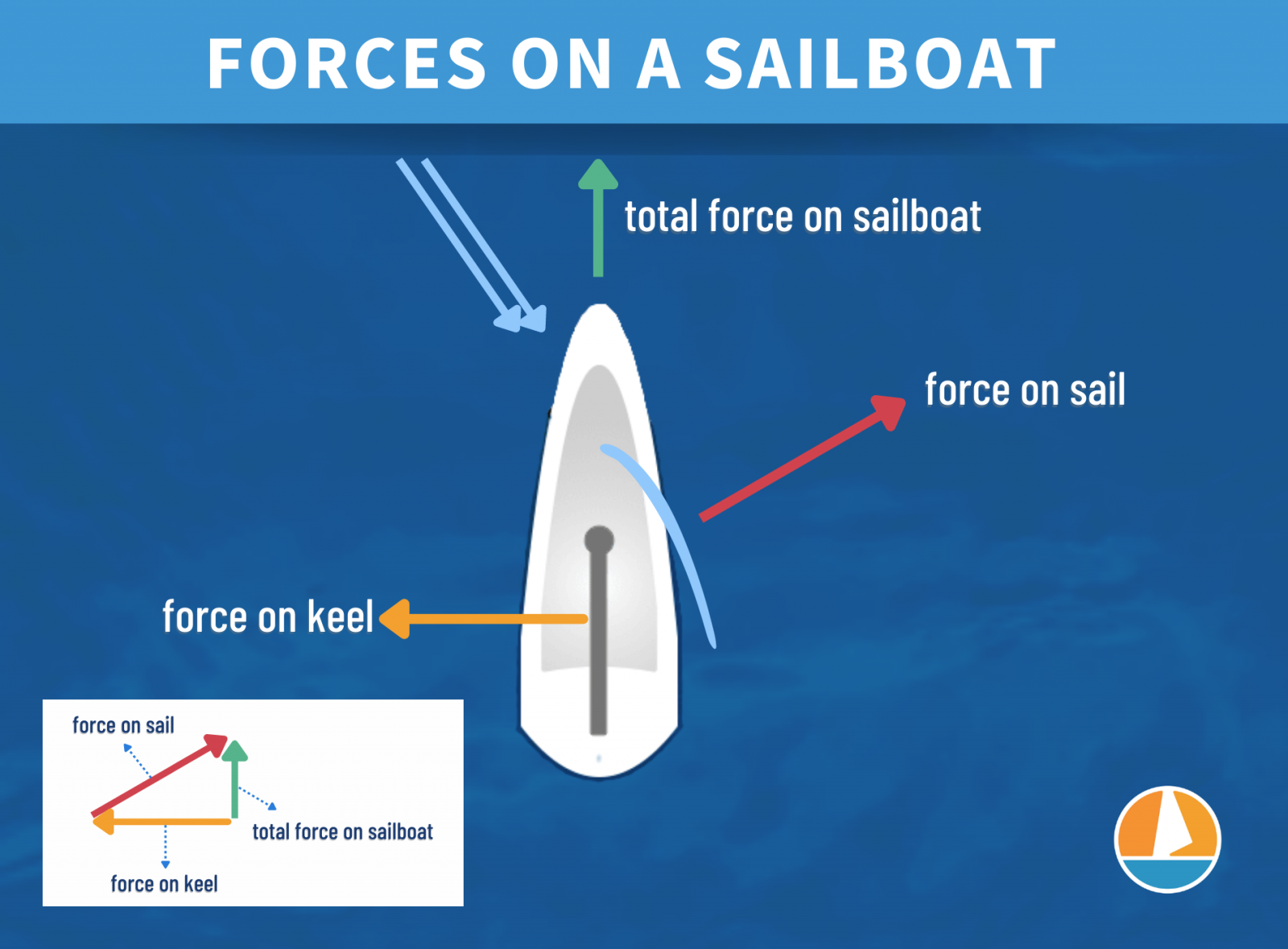
Now, add them.
You don't have to do it on paper, as long as you can see that those vectors, when added together, result in a vector that nets a forward motion of the hull through the water. There's your answer.
Any yacht designer will tell you there's much more to getting the correct forward vector. And this is true. The shape of the hull, the smoothness of the bottom, and a few other factors will affect the final forward forces on the boat.
But at its core, the lift vector from the sails added to the keel vector ends up in the boat being pulled forward.
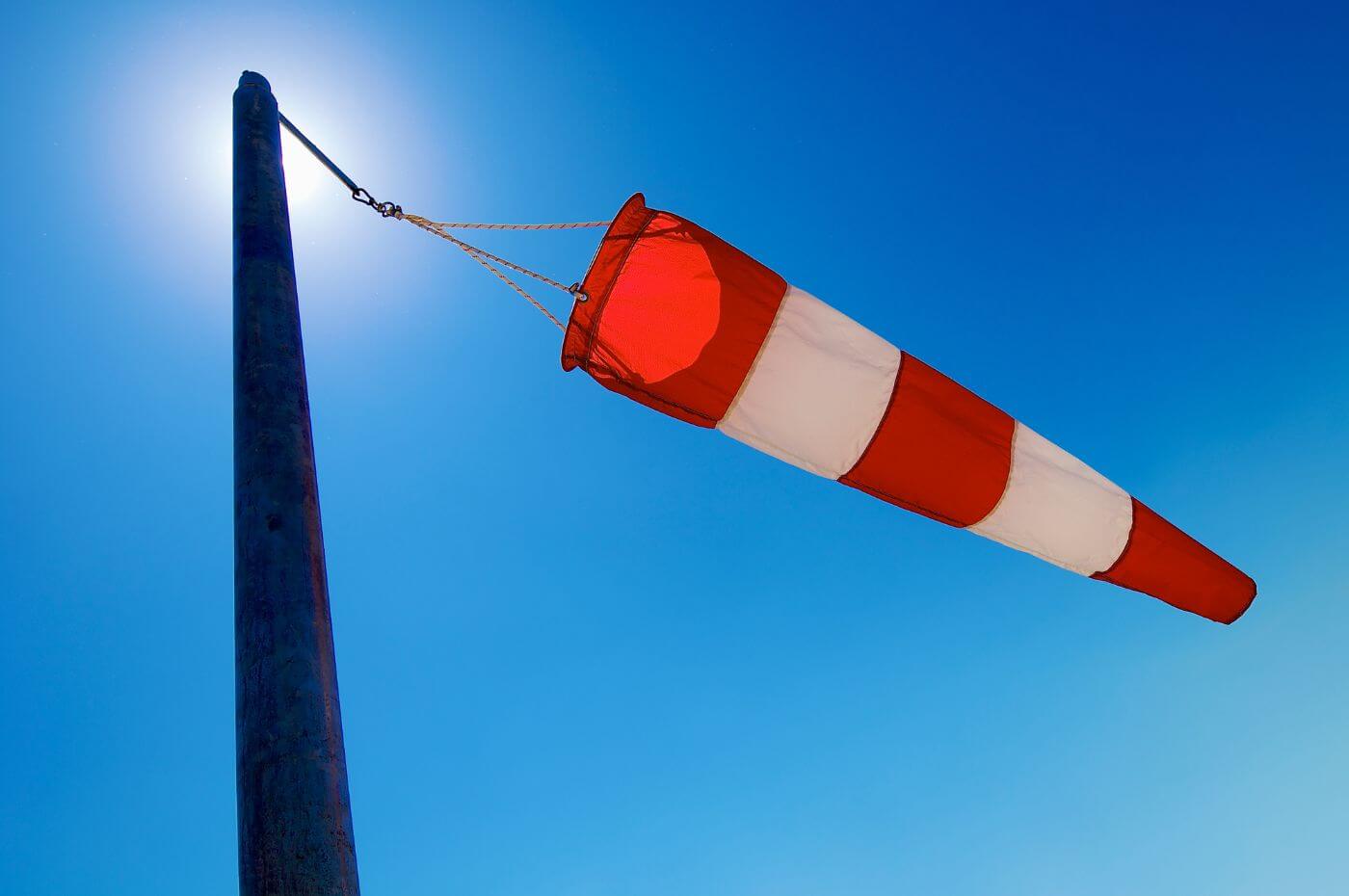
Why is It Easier to Sail Downward?
What makes a boat sail downwind is much simpler than the mashup of force vectors we had to work through for upwind sailing. It's quite simple really - the sails fill with wind and pull on the boat to push/drag it downwind.
When you're not going against the wind, the physics is a lot simpler.
Not that you can't look more closely at the forces involved to maximize your speeds and find the best way to sail downwind. But we're not asking how to trim for speed, we're asking how the boat moves. And heading downwind, your full sails catch as much wind as possible to put as much propulsive force onto the hull as possible.
Applying Your Knowledge of Sails
If you've gotten this far, you may wonder "now what?" The next step is to apply that knowledge to sail your boat. Now that you know you can change sail shapes for speed and power and why that works, check out our complete guide to trimming sails so you can trim better and sail faster.
Did you find the answer to your specific question?
👍 3 👎 1
Leave a comment